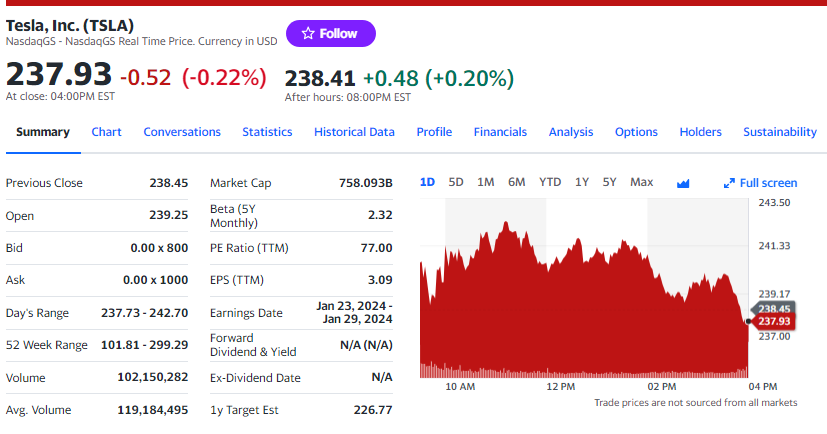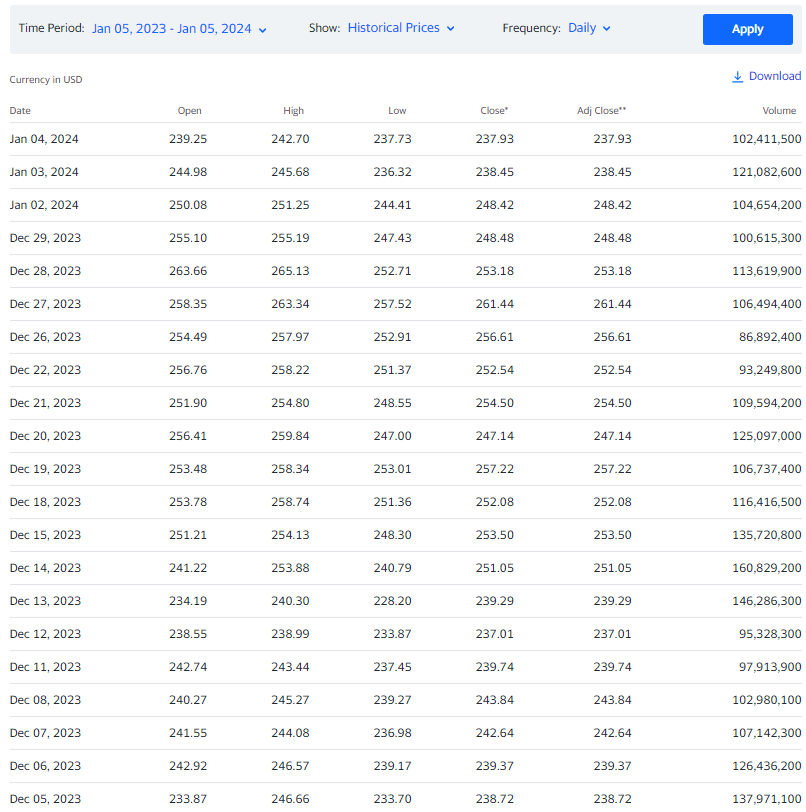This website and its content are not intended to provide professional or financial advice. The views expressed here are based solely on the writer’s opinion, research, and personal experience, and should not be taken as factual information. The author is not a financial advisor and lacks relevant certifications in that regard. We highly recommend consulting a qualified financial advisor before making any investment decisions, as the information presented on this site is general in nature and may not be tailored to individual needs or circumstances.
Contents
Tesla Inc. (TSLA) stands as a formidable force in the stock market, particularly within the electric vehicle (EV) sector. Trading at a price of $237.93, Tesla’s stock mirrors the company’s significant role in shaping the future of automotive technology and sustainable transport.
Tesla’s journey in the stock market is more than just a reflection of its financial health; it’s a testament to its pioneering role in the EV revolution. The company has consistently pushed the boundaries of what’s possible in automotive technology, making electric vehicles not just a viable option but a desirable one. This innovation has been a key driver of investor confidence, contributing to Tesla’s robust market valuation.
The company’s influence extends beyond its groundbreaking electric vehicles. Tesla has been at the forefront of developing cutting-edge battery technology and autonomous driving systems, setting new benchmarks for the automotive industry. These technological advancements have not only enhanced Tesla’s product range but have also fortified its competitive edge against both traditional car manufacturers and new entrants in the EV space.

Investor interest in Tesla is also closely linked to its dynamic CEO, Elon Musk. Musk’s vision for the company and his influential leadership style have been pivotal in shaping Tesla’s market perception. His decisions and public statements often have a direct and immediate impact on the stock’s performance, underscoring the unique interplay between corporate leadership and stock market dynamics.
Tracing Tesla’s Stock History
Tesla’s stock history is a compelling story of growth and market dynamics, marked by notable numbers that illustrate the company’s journey.
Short-Term and Long-Term Trends
In the short term, Tesla’s stock has been characterized by notable fluctuations. For example, in the past year, the stock has experienced swings from highs around $300 to lows near $200, often reacting to market news, product announcements, and financial reports.
Over the long term, Tesla’s growth trajectory is impressive. From its initial public offering (IPO) in 2010 at $17 per share, the stock has seen a significant increase:
- 2010 (IPO): Priced at $17 per share.
- 2015: Averaged around $220, reflecting steady growth and market confidence.
- 2019: Reached approximately $420, buoyed by new model announcements and expansion plans.
- 2021-2023: Characterized by high volatility but overall upward trend, with peaks surpassing $900 and adjusting to market conditions.
Comparative Analysis with Past Performance
Comparing Tesla’s current stock performance with its past provides a clearer picture of its market journey:
- IPO to 2015: The stock grew over 12 times its IPO value, a sign of Tesla’s emerging market presence.
- 2015 to 2019: Nearly doubled in value, indicating growing investor confidence and market penetration.
- 2019 to 2023: More than doubled again, despite volatility, highlighting Tesla’s resilience and innovation in the face of industry challenges.
These figures not only demonstrate Tesla’s financial growth but also mirror the company’s evolution in the automotive industry and its pivotal role in the EV market. Tesla’s ability to navigate market fluctuations and maintain an upward trajectory reflects its strong market position and the increasing importance of sustainable transportation solutions. As Tesla continues to innovate and expand, its stock remains a vital indicator of the company’s health and the broader potential of the EV industry.

Tesla’s Financial and Earnings Landscape
Examining Tesla’s financial and earnings landscape is essential for investors seeking a comprehensive understanding of the company’s fiscal health and growth potential.
Recent Earnings Reports
Tesla’s recent earnings reports provide valuable insights into its financial performance. Key components to consider include:
- Revenue Growth: Evaluating Tesla’s revenue growth over specific periods, such as quarterly and annually, offers an indication of its ability to generate income. A consistent uptrend in revenue suggests strong market demand for its products and services.
- Profitability: Assessing Tesla’s profitability metrics, including net income and gross margin, helps investors gauge the company’s efficiency in converting revenue into profits. A consistent increase in profitability is generally a positive sign.
- Cash Flow: Analyzing Tesla’s cash flow statements reveals its ability to generate cash from its operations and whether it can fund its growth initiatives without excessive reliance on external financing.
- Operating Expenses: Monitoring operating expenses, such as research and development, and selling, general, and administrative costs, helps investors understand how efficiently Tesla manages its operations.
Revenue Trends and Profitability Metrics
Tesla’s revenue trends and profitability metrics provide valuable insights into its financial health:
- Revenue Growth: Tesla has consistently reported impressive revenue growth over the years, reflecting the strong demand for its electric vehicles and energy products. Revenue figures have shown a remarkable increase from its early years as a public company.
- Gross Margin: Tesla’s gross margin, a measure of profitability, has been a key indicator of its ability to produce vehicles profitably. The company’s ability to improve gross margins over time has been instrumental in its financial success.
- Net Income: Tesla’s net income, while subject to fluctuations, has demonstrated a positive trajectory, reflecting its commitment to achieving profitability. Key milestones, such as achieving full-year profitability in 2020, have boosted investor confidence.
Debt and Liquidity Analysis
Tesla’s financial stability is also influenced by its debt and liquidity position:
- Debt Levels: Monitoring Tesla’s debt levels and debt-to-equity ratio helps assess its leverage and financial risk. The company’s ability to manage and reduce debt is a crucial consideration for investors.
- Cash Reserves: Tesla’s cash reserves and liquidity position determine its ability to meet short-term obligations, invest in research and development, and fund expansion plans. Strong cash reserves are indicative of financial stability.
- Capital Raises: Understanding Tesla’s history of capital raises, including equity offerings and debt issuances, can provide insights into its funding strategies and its ability to access capital markets.
Tesla in the Competitive Automotive Arena
Tesla’s position in the competitive automotive arena is marked by both challenges and opportunities as it navigates a landscape characterized by established automakers, newcomers, and evolving consumer preferences.
Established Automakers’ Response
Tesla’s success in the electric vehicle (EV) market has prompted established automakers to respond:
- Accelerated EV Strategies: Many traditional automakers have expedited their EV strategies, with plans to introduce electric vehicles across various segments. This heightened competition is driven by the recognition of EVs as the future of the automotive industry.
- Investment in Technology: Established automakers are investing heavily in research and development to match Tesla’s technological advancements. This includes developing electric powertrains, autonomous driving systems, and energy-efficient vehicles.
- Expanding EV Lineups: Automakers are expanding their EV lineups to cater to a broader range of consumers, offering more choices and price points. This diversification is in response to Tesla’s ability to appeal to various market segments.
New Entrants and Startups
Tesla’s success has also attracted a wave of new entrants and startups entering the automotive arena:
- Focus on Niche Markets: Some startups are targeting niche markets with specialized electric vehicles, such as electric trucks, high-performance sports cars, and urban mobility solutions. This diversity reflects the evolving landscape of EV offerings.
- Innovative Business Models: Startups often adopt innovative business models, including direct-to-consumer sales and subscription-based services, challenging traditional dealership networks.
- Partnerships and Collaborations: Collaborations between startups and established companies are becoming more common, fostering innovation and expanding market reach.
Consumer Preferences and Market Dynamics
Tesla’s role in shaping consumer preferences and market dynamics is significant:
- Increased EV Awareness: Tesla’s high-profile success has increased consumer awareness and interest in EVs, leading to higher EV adoption rates worldwide.
- Elevated Expectations: Tesla has set high standards for EVs in terms of performance, range, and technology. Consumers now expect similar features from other EV manufacturers.
- Infrastructure Development: Tesla’s Supercharger network has prompted the development of charging infrastructure by other stakeholders, including governments, energy companies, and automakers.
Investor Perspectives and Future Outlook for Tesla
Investor perspectives on Tesla (TSLA) are shaped by a combination of factors, including the company’s financial performance, market dynamics, and broader industry trends. As we look ahead, considering the future outlook for Tesla is essential for investors seeking to make informed decisions.
Bullish Sentiment
Many investors maintain a bullish perspective on Tesla, driven by several key factors:
- Innovation Leadership: Tesla’s track record of innovation in electric vehicles, battery technology, and autonomous driving positions it as a leader in the industry. This innovation is expected to continue driving growth.
- Market Expansion: Tesla’s international expansion efforts, including new Gigafactories and manufacturing facilities, signal its commitment to global growth. Investors see these expansions as opportunities for increased market share.
- Sustainability Focus: Tesla’s commitment to sustainability aligns with growing environmental awareness. Investors view Tesla as a company that not only offers financial potential but also contributes positively to addressing climate change.
- Strong Brand: Tesla’s strong brand recognition and consumer loyalty are valuable assets. Investors anticipate that Tesla will maintain its brand strength, further bolstering its market position.
Bearish Sentiment
Conversely, some investors hold a bearish perspective on Tesla, citing concerns such as:
- Valuation: Tesla’s valuation is often a topic of debate, with some investors expressing concerns that the stock may be overvalued relative to traditional automakers and industry peers.
- Competition: The increasing competition in the electric vehicle market raises questions about Tesla’s ability to maintain its market share and premium pricing.
- Regulatory Risks: Regulatory scrutiny of Tesla’s autonomous driving systems and safety concerns could potentially lead to legal challenges and impact the company’s stock performance.
- Production Challenges: As Tesla continues to expand production capacity, there are concerns about potential production bottlenecks, quality control issues, and supply chain disruptions.
Future Outlook
The future outlook for Tesla remains dynamic and influenced by various factors:
- Technological Advancements: Tesla’s continued focus on innovation, including battery technology and autonomous driving, will play a significant role in its future growth and market positioning.
- Competition: Tesla will face increasing competition from both traditional automakers and new entrants. Its ability to differentiate itself and maintain technological leadership will be key.
- Global Expansion: Tesla’s expansion into international markets and its ability to tap into emerging economies will contribute to its growth potential.
- Sustainability Initiatives: As the world shifts towards cleaner energy and sustainable transportation, Tesla’s commitment to sustainability is expected to resonate with consumers and investors alike.
Addressing Key Questions about Tesla’s Stock
Investors often have questions and concerns when considering Tesla (TSLA) as an investment. Addressing these key questions can provide valuable insights into the company’s stock and its place in an investment portfolio.
Assessing Tesla’s valuation requires considering traditional metrics like price-to-earnings (P/E) ratios and comparing them to industry peers. However, Tesla’s unique position in the electric vehicle and clean energy sectors may justify a premium valuation. Investors should conduct thorough research and consult financial experts to form their own conclusions.
Tesla’s growth potential is closely tied to its ability to expand production, introduce new products, and capture a larger share of the global electric vehicle market. Additionally, Tesla’s focus on technology, autonomous driving, and sustainable energy solutions could open new growth avenues.
Competition in the electric vehicle market is intensifying, with both established automakers and startups entering the space. Tesla’s ability to maintain its technological edge, brand strength, and innovation will be crucial in navigating the competitive landscape.
Tesla faces regulatory scrutiny, particularly regarding its autonomous driving systems. Potential changes in safety standards and regulations could impact the company’s operations and stock performance.
Tesla’s long-term strategy includes international expansion, technological innovation, and a focus on sustainability. Investors should assess how well the company executes this strategy and its implications for stock performance.
Conclusion
Tesla’s journey in the dynamic auto industry is marked by a blend of unparalleled opportunities and formidable challenges. The company’s relentless innovation, global expansion, and commitment to sustainability position it as a pioneering force in the electric vehicle and clean energy sectors. Tesla’s ability to capitalize on its growth potential, navigate increasing competition, and address regulatory and production challenges will undoubtedly shape its future. While questions about valuation persist, Tesla’s unique position as a catalyst for environmental change and mobility transformation continues to captivate investors and redefine the future of transportation.
As the automotive landscape evolves, Tesla’s story serves as a testament to the transformative power of innovation and the profound impact a single company can have on an entire industry. While uncertainties remain, Tesla’s opportunities to lead the charge towards a sustainable and electrified future are vast, and its resilience in addressing challenges reinforces its status as an industry pioneer.
StockHax strives to provide unbiased and reliable information on cryptocurrency, finance, trading, and stocks. However, we cannot provide financial advice and urge users to do their own research and due diligence.
Read More


